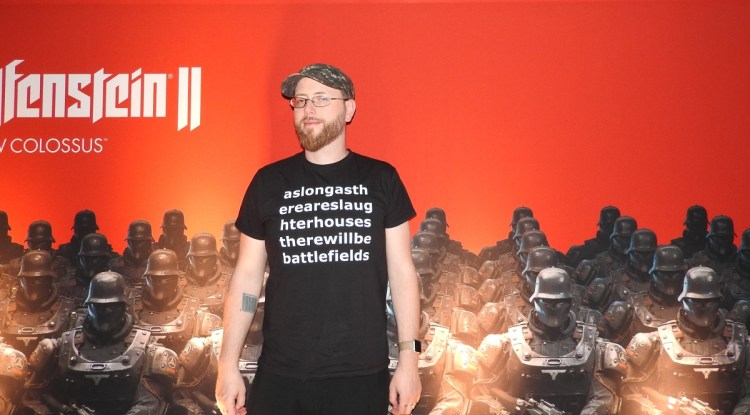There’s a new preview out for Wolfenstein II: The New Colossus, and it will give you the creeps. In fact, it will make you so angry that you’ll have no compunctions blasting the Nazis who have taken over America in this upcoming video game.
Just as it did with Wolfenstein: The New World Order in 2014, Machine Games is flexing its creativity in showing what America would look like if the Nazis had won World War II and went on to conquer the United States. You’ll see Americans kowtowing to the Nazi officers, and Klansmen roaming the streets freely.
I interviewed Jens Matthies, creative director of Wolfenstein II: The New Colossus, at the Electronic Entertainment Expo (E3), the big video game trade show in Los Angeles in June. But then I attended another preview event and played most of an exciting new level where the hero, BJ Blazkowicz, goes into a secret Nazi underground research center in Roswell, New Mexico. After I played it, I felt a bit dizzy. But I had a chance to interview Matthies a second time about the new preview.
It’s a serious first-person shooter with all sorts of creative elements. Matthies’ Machine Games created all sorts of cultural artifacts that add to the spookiness of the Nazis taking over America in the 1950s and 1960s. I talked with Matthies about that and my other experiences playing the new level. We talked about whether it was too easy or too hard, and the difficulty of tuning a game to be just right. The game debuts on October 27 on the PC, PlayStation 4, and Xbox One.
June 5th: The AI Audit in NYC
Join us next week in NYC to engage with top executive leaders, delving into strategies for auditing AI models to ensure fairness, optimal performance, and ethical compliance across diverse organizations. Secure your attendance for this exclusive invite-only event.
Here’s an edited transcript of our interview. (See our preview story here on Roswell, and Bethesda’s Season Pass plan here).

Above: Wolfenstein II’s depiction of the Nazis in America.
GamesBeat: The demo made me a little woozy. Is it 30 or 60 frames per second?
Jens Matthies: Yeah, it’s 60.
GamesBeat: It shouldn’t throw me off that badly.
Matthies: Well, it’s different from person to person. Maybe you can take some seasickness pills. [laughs]
GamesBeat: In this kind of level, do you detect the state of my resources? When I needed a medkit, I always eventually found one.
Matthies: No, that’s just clever people placing the pickups in the right spots. We did have some smart allocation for the loot system in the first game.
GamesBeat: So your state of health or ammo would—
Matthies: It would affect what enemies dropped, yeah. But I don’t think that made it into the final build.
GamesBeat: I made the mistake of saving with 10 health, and then I had to go up against several of those fast guys, the ones with the orange thing?
Matthies: We call them the Ubersoldier. The ones that move really fast sideways. They can move really rapidly on the ground in any direction, but they can also jump and attach to walls. They have that chest cannon they can fire when they’re on the wall. They don’t take so much damage, though. They’re easy enough to kill if you can hit them, but they’re hard to hit.
GamesBeat: I started throwing grenades at them.
Matthies: That works for most things.
GamesBeat: Then I discovered the lower path on the train.
Matthies: The sneaky one, right.
GamesBeat: The hallmark of open design seems to be that it makes for a pretty hard game. Are there more gradations of difficulty in this? Do you need to give people more suitable choices?
Matthies: Oh, for sure. We have a lot of difficulty levels. But where we added stuff was mainly on the harder end. There are a lot of those players who just have an insane amount of skill. To them, it feels like everything is too easy. So we made sure to include some exceptionally hard settings.
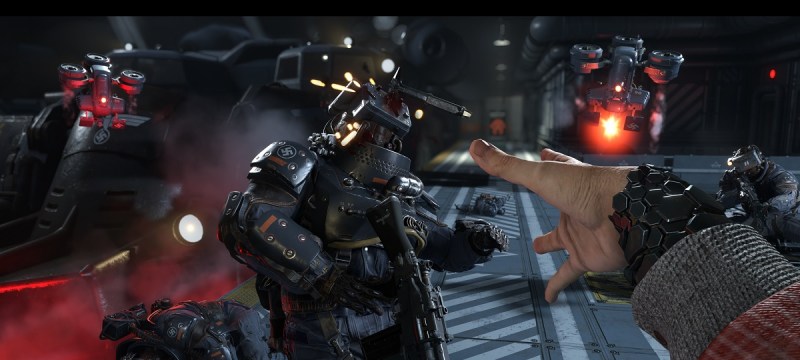
Above: Furious action in Wolfenstein II
GamesBeat: You don’t want people doing this on a speed run.
Matthies: Well, they can try, of course. Speed runs are always amazing to see. It’s so clever, what they figure out about games, the level of understanding they have about the games. I think also why it gets trickier in a demo like this is because there’s a lot of training that occurs in the buildup to the level. When you go in without that training of course it gets harder.
GamesBeat: As far as Roswell and why we’re there, what can you say about the story going on in this part of the game?
Matthies: Without going into too many spoilers, we involve some of the Roswell mythology in the story of the game. But it’s also a really interesting way for us to show what sort of Main Street America would be like under Nazi oppression. We felt like it ticked a lot of boxes as far as what made us excited about going to that place.
GamesBeat: Yeah, the beginning scene in the town, where the commandant asks you for your identification, that was very well done. It’s creepy. The town had an awful lot of detail, too. Everywhere you look there’s something to notice.
Matthies: We love that, building something and then figuring out where to layer that detail in. We do a lot of that over time. It depends on having a strong commitment to an idea in the beginning, and then you build on that as time goes on and you learn more about it.
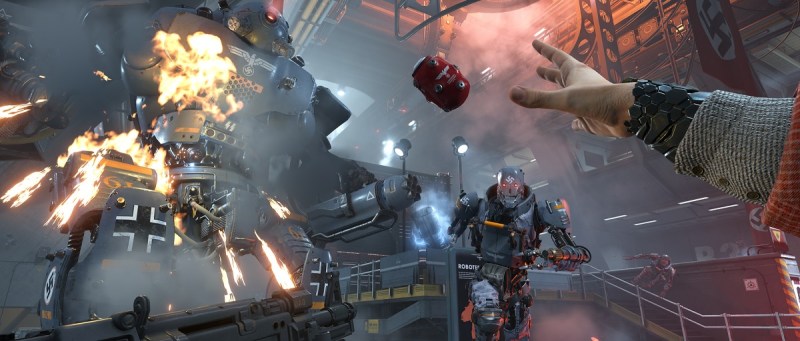
Above: Combat is always a frenzy in Wolfenstein II.
GamesBeat: The last time you described this as a sort of Nazified Americana.
Matthies: It’s interesting for us to work with that on a creative level. What would it look like if the Nazis were trying to subvert American culture?
GamesBeat: I like his comment about how there should be more German food on the menu.
Matthies: Right. Just a slow, constant dialing up of the pressure over the decade that they’ve been there. Every year things get progressively more intense. In one year it’s the big changeover day where everyone has to start speaking German and it becomes the national language.
GamesBeat: It almost seems more fun to explore all that detail than dive into the gameplay. It’s an interesting combination of story in the campaign.
Matthies: We’re equally committed to both, for sure. Something we’ve done well is try to divide responsibilities for different areas of the game. Where I’m in charge of the storytelling side of things, there are other people in charge of the gameplay side. We’re equally committed to making sure those things are as strong as they can be. Of course, we work together so much – we make sure that whatever gets done with the story, the gameplay can support it, and vice versa.
It’s a risk if you have the same people responsible for all the dimensions of the game. Everybody has their natural inclination toward something they like to do or they’re passionate about. If I were in charge of the gameplay as well, the gameplay probably wouldn’t be as good, because I would—when there’s a conflict, the story would win out. But now that doesn’t happen, because we’re equally sticking up for all the areas of the game. I think that’s very important. There are many examples of games out there where the gameplay is amazing, but the gameplay is clearly an afterthought, or the story is amazing, but the gameplay feels tacked on to that.
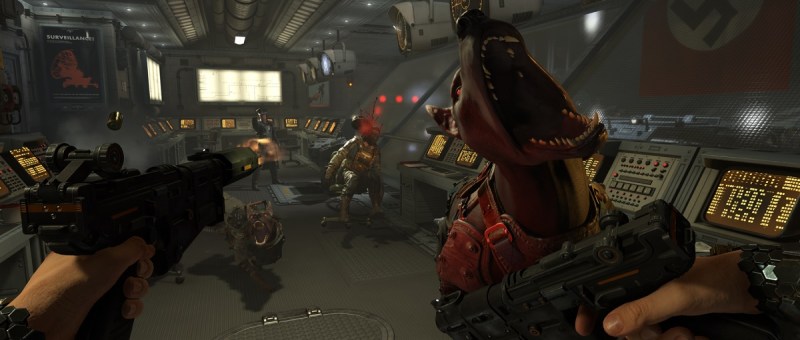
Above: A deadly dog in Wolfenstein II
GamesBeat: Have you heard of Richard Bartle? He’s a professor in England who came up with a model of player types in MMOs — socializers and killers and explorers. He discussed in another talk recently about how hard it is to design a game that makes different kinds of players happy. You need enough content to satisfy players, but if you offer too much of the same kind of content, people start to perceive that as a grind, something with no purpose. So you get to this idea of a meaningful kind of gameplay – if you have a mission or a story that you want to finish, that seems to be the right kind of combination.
Matthies: I completely agree with that. That’s been a big part of our mission since we started making games, figuring out how to pace that. I think we’ve gotten progressively better at it over the years. We’re always conscious of pacing. But it’s not only the difference between action and non-action. It’s different kinds of intensity. A quiet scene can be dramatically intense, while an action scene can be intense in different ways, or maybe the same way. But when you make a game like this that has a strong narrative – that has a beginning, middle, and end – you have to be conscious of the pacing so that you’re not overstaying your welcome in any kind of moment.
GamesBeat: Your cinematics can be very tense, like when the commandant’s questioning you.
Matthies: Right. There’s no action there, but it’s intense in a different way. You don’t really know how that’s going to end.
GamesBeat: When Frau Engel shows up, you know it’s going to be some kind of tense conversation.
Matthies: Right. [laughs] Exactly. A big challenge is making everything just work conceptually at first, on paper. We’ll sit down for long periods of time just analyzing how things go together and questioning everything. “Is this going on too long? Is this part too tedious? How quickly should we get to the end of this?” In the early stages of development, we’re constantly feeling out that process and changing things.
GamesBeat: Do you think there are some big distinctions in that area between this game and the first Wolfenstein?
Matthies: There are a lot of differences in the sense that we’re on a completely new engine and rebuilt everything in that area. But I think our core philosophy as a group is the same, in that we’re trying for a really ambitious narrative fused with a really ambitious, mechanically sound first-person shooter. But then of course there are different things we want to achieve with this story, different emotional beats. In terms of tone, it’s very similar, straddling that line between over-the-top craziness and intimate scenes, really dramatic stuff, heavy stuff. I think people will feel right at home if they enjoyed the first one.
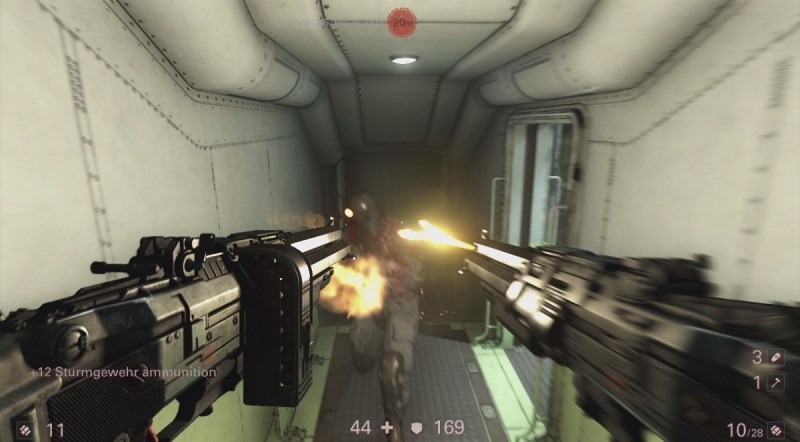
Above: Dual wielding is the way to go in Wolfenstein II: The New Colossus.
GamesBeat: The Nazis seem to have kept their ingenuity when it comes to crazy war machines.
Matthies: That’s true. For us as developers, that’s one of the cool things about taking place in this alternate history, where technology is really advanced. We can do all kinds of crazy stuff. It’s a lot of fun coming up with new things.
GamesBeat: Are there any other important things you think these two levels convey?
Matthies: Our games are always very challenging when it comes to showcasing what they’re about. There’s a lot of variation. Each level is unique compared to each one before, and within each level there are quite a lot of different beats as well. We have this holistic approach early on when we map out the game – you go from here to here to here, this happens and that happens. As a whole that feels very strong, and that’s what we start building. But the challenge is always to reflect that idea of the whole when we show a part. But that’s a good starting point.
GamesBeat: It’s hard to represent that whole arc in one level.
Matthies: Especially when it’s part of a sort of super-arc.
GamesBeat: Was that all original music I was hearing in some of these scenes, the background music?
Matthies: Oh, yeah. We have two amazing composers – Mick Gordon, who did the score for the first game, and also another guy, Martin Stig Andersen, a Danish guy, who worked on Limbo and some other things. They turned out to be this super team. We’re so happy with the score. It’s just amazing. They’re very complementary of each other, a very strong combination throughout the game.
GamesBeat: I wondered if some of the songs on the radio were drawn from life, like “House of the Rising Sun” from the first game.
Matthies: There’s a little bit of that. The focus has shifted a bit more to other things for this game. But there’s still some of that in there.
